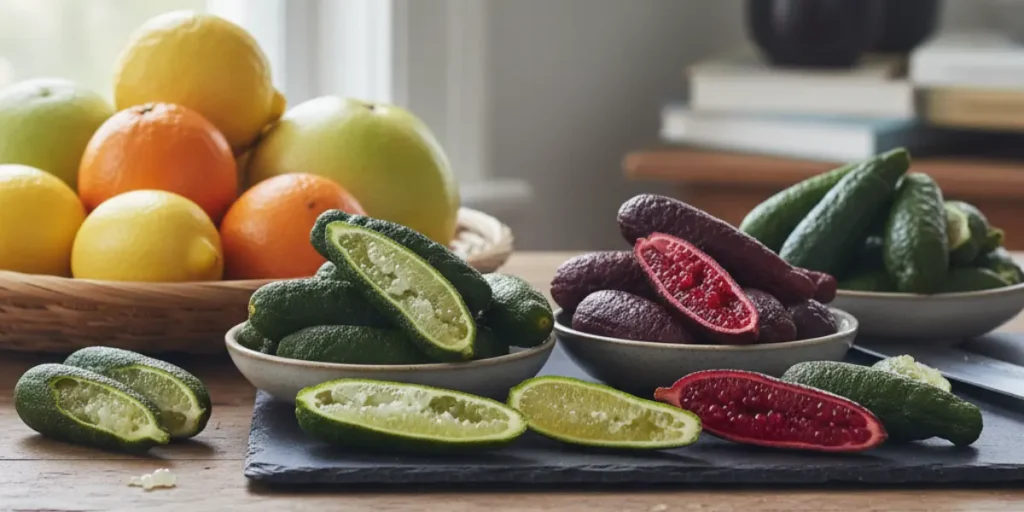How Finger Limes Differ Botanically from Traditional Citrus Fruits

The term "citrus fruit" is often used to refer to traditional fruits like oranges, lemons, and limes. They are used around the world in both home and commercial kitchens equally.
However, when you dive deep into the lime, you will find that citrus fruit, or we can call it finger limes, is different from the usual fruit category.
But what sets it apart from the rest of its family? Let’s find out.
Unique Botanical Characteristics: Finger Lime Plant Characteristics
Finger limes are now loved by chefs around the world, especially in the USA and the Middle East. However, some may know them from the Australian lands; they are now grown in many other regions, too.
What people entirely miss is the botanical characteristics of the finger lime plant.
What sets it apart from other lime plants? And why do we even need to know? It has unique characteristics. Yes, thorny branches and tiny in size with dark leaves.
It grows better in tough and dry conditions. But unlike the usual rounded shape of citrus trees, finger lime trees are more shrub-like and can grow up to five meters tall, often sprawling in different directions.
When it comes to their flowers, finger limes have smaller but much more colorful blooms, ranging from pale pink to creamy white.
In traditional citrus flowers, they tend to be mostly white. The fruit itself has a thin, leathery rind that can come in various colors, including green, yellow, and even deep red or purple. Then, there are red finger limes that are especially sought after for their stunning ruby-colored pearls, which bring both a pop of color and a zesty flavor to dishes.
Caviar Lime vs Regular Lime – A Sensory Comparison
When you compare finger lime vs traditional citrus, you’ll notice that they differ in ways that go beyond just looks. It is easy to get confused, but really?
Regular limes, such as Tahitian and Key limes, have a consistent pulp and a sharp, strong acidity. In contrast, finger limes bring a unique flavor profile; they’re tart, yet with a hint of sweetness, along with some floral and herb notes. So, the taste is completely different.
Additionally, the texture is a game-changer, too. Rather than the usual citrus pulp, finger limes have these bead-like vesicles that burst in your mouth, giving that caviar-like experience. This unique feel is what makes finger limes popular in fine dining and cocktail crafting, where chefs love using them to elevate seafood dishes, desserts, and drinks.

Top Botanical Difference Between Finger Lime and Citrus
When you look at genetics, the difference between finger limes and regular citrus fruits is quite striking.
- Standard citrus, like oranges, lemons, and grapefruits, mainly come from the species Citrus reticulata, Citrus sinensis, and Citrus paradisi, all in the Rutaceae family. Finger limes are also from that family, but they belong to a subgenus called Microcitrus, indicating they've taken a different evolutionary path.
This divergence has led to some interesting reproductive traits and hybrid possibilities for finger limes.
- They can crossbreed with other citrus types, but usually the hybrids showcase unique finger lime characteristics, such as their elongated form or caviar-like pulp.
This ability to adapt has given rise to a variety of finger lime types, each with its own mix of color, size, and flavor strength.
What Do You Need to Know About the Versatility of Finger Lime Varieties?
Citrus finger lime varieties are incredibly diverse. You've got green-skinned ones with tangy pearls, and then there are the pink and red varieties that bring a sweet, aromatic vibe. Each type delivers a unique sensory experience.
What’s cool is that the color of the pearls shifts as they ripen, making them even more visually appealing. In culinary settings, chefs often use the green or yellow limes to add a zesty kick to seafood dishes, while the red ones are perfect for desserts and cocktails, thanks to their bright color and gentle sweetness.
But it's not just about food. Finger limes are also making waves in the skincare and nutraceutical worlds because they’re packed with vitamin C and antioxidants, sometimes even more than regular citrus fruits.
Conclusion
When exploring citrus fruits, finger limes truly stand out for their distinct structure, taste, and nutritional profile. Rich in antioxidants and vitamin C, they’re valued both in gourmet cuisine and wellness industries.
For those searching for finger limes near me, Citron Caviar makes it easy to enjoy this rare delicacy, being a trusted global exporter of citrus caviar.
Our commitment to quality and freshness ensures you get premium finger limes that bring flavor, health, and elegance to every dish. Whether used in food, drinks, or skincare, finger limes remain a unique citrus treasure worldwide.
FAQs
Finger limes belong to the Microcitrus subgenus, featuring elongated fruit and caviar-like pulp vesicles, unlike typical citrus fruits that have smooth pulp and round shapes.
Yes, finger limes are part of the Rutaceae family, just like lemons and oranges, but they belong to a unique subgenus, giving them a distinctive texture and genetic traits.

